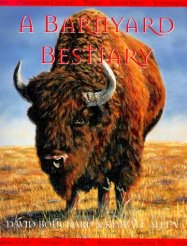|
________________
CM . . . .
Volume VI Number 16 . . . . April 14, 2000
excerpt: We are voices from the barnDave Bouchard, known for capturing the thoughts of a severally physically challenged man in the moving If Sarah will Take Me, has applied his poetic talents to voicing the plight of rare and endangered domestic animals. Because they are not as flashy or dangerous as their wild counterparts, little attention has been paid to them. In free verse, accompanied by realistic paintings meticulously rendered by Kimball Allen, the animals speak directly to us of their histories and the injustices they've suffered from mankind. We hear from great shaggy beasts like the Highland Cow and the Buffalo; from the common goose, turkey and donkey; and from rare animals like the Blonde Mangalitza Pig. Throughout all the poems, Bouchard weaves the theme of how domestic creatures have been taken for granted, neglected or misused by man. The animals contemplate how people believe that the world is meant for them and that all of nature is secondary; important only in relation to how it can be used. They feel both puzzled and betrayed by this, and their resigned acceptance is palatable in these poems. However, the bleakness is relieved in the last poem, where the Border Collie speaks up for man and offers to teach his "best friend" to learn to be a better friend to animals. While the publisher suggests ages 4 to 8, the poetic style and vocabulary require a more advanced comprehension. Young children, and indeed all readers, will respond to the beautiful artwork which varies from full-length portraits to close-ups of an animal's unique features. The ostrich painting is particularly striking in perspective, showing only lowered heads and necks framed by skinny legs. In all the pictures, Allen has carefully detailed the animals' traditional surroundings to provide a sense of place. This combination of cautionary poems and spectacular art will help readers of all ages to see their world differently. Recommended. Alison Mews is the Director of the Canadian Materials Centre in the Faculty of Education at the Faculty of Education, Memorial University of Newfoundland in St. John's, NF.
To comment on this title or this review, send mail to cm@umanitoba.ca.
Copyright © the Manitoba Library Association.
Reproduction for personal use is permitted only if this copyright notice
is maintained. Any other reproduction is prohibited without
permission.
Published by
TABLE OF CONTENTS FOR THIS ISSUE - April 14, 2000.
AUTHORS |
TITLES |
MEDIA REVIEWS |
PROFILES |
BACK ISSUES |
SEARCH |
CMARCHIVE |
HOME
|
